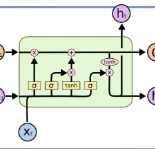In order to improve the vessel's capacity and ensure maritime traffic safety, vessel intelligent trajectory prediction plays an essential role in the vessel's smart navigation and intelligent collision avoidance system. However, current researchers only focus on short-term or long-term vessel trajectory prediction, which leads to insufficient accuracy of trajectory prediction and lack of in-depth mining of comprehensive historical trajectory data. This paper proposes an Automatic Identification System (AIS) data-driven long short-term memory (LSTM) method based on the fusion of the forward sub-network and the reverse sub-network (termed as FRA-LSTM) to predict the vessel trajectory. The forward sub-network in our method combines LSTM and attention mechanism to mine features of forward historical trajectory data. Simultaneously, the reverse sub-network combines bi-directional LSTM (BiLSTM) and attention mechanism to mine features of backward historical trajectory data. Finally, the final predicted trajectory is generated by fusing output features of the forward and reverse sub-network. Based on plenty of experiments, we prove that the accuracy of our proposed method in predicting short-term and mid-term trajectories has increased by 96.8% and 86.5% on average compared with the BiLSTM and Seq2seq. Furthermore, the average accuracy of our method is 90.1% higher than that of compared the BiLSTM and Seq2seq in predicting long-term trajectories.
翻译:为提高船舶的能力和确保海上交通安全,船舶智能轨迹预测在船舶智能导航和智能避免碰撞系统中发挥着关键作用。然而,当前研究人员仅侧重于短期或长期船舶轨迹预测,导致轨迹预测不够准确,全面历史轨迹数据缺乏深入挖掘。本文件建议采用自动识别系统(AIS)数据驱动的长期短期内存(LSTM)方法,该方法以前方子网络和逆向子网络(称为FRA-LSTM)的结合为基础,以预测船舶轨迹。我们方法中的前方子网络将LSTM和关注前方历史轨迹数据中地雷特征的注意机制结合起来。同时,逆向子网络将双向LSTM(BILSTM)和后方历史轨数据中地雷特征的注意机制结合起来。最后预测轨迹是利用前方和逆向子网络的产出特征生成的。根据大量实验,我们提出的预测短期和中程轨道轨迹的方法的准确性在预测短期和中期轨道数据预测中,比双行距的SIRCM的平均值增加了96.8%,比比双程的Sque值平均的精确率增加了SIM的准确率。




